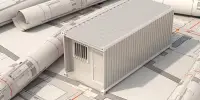Underwater concrete structures are subjected to non-destructive testing (NDT) as part of structural investigations, regular preventative maintenance schedules, or studies precipitated by an accident or major event. Sounding, echo sounders, side-scan sonar, and other techniques are some of the underwater concrete NDT methods.
The NDT techniques and tools utilized for underwater concrete investigation are discussed in this article.
Sounding Technique
One of the basic NDT techniques used in construction is sounding. By striking the concrete surface, soundings (data gathered through sounding) are taken using this technique. The method finds interior cracks or concrete cover delamination.
An overall condition of the concrete surface is derived from the soundings obtained. The results are qualitative, but it is rapid and economical. As the test is conducted underwater, the ability to detect sounds by inspection is reduced.
Magnetic Reinforcing Bar Locator
A magnetic reinforcing bar locator or pachometer determines the location of reinforcing bars in concrete, the depth of concrete cover, and the size of reinforcing bars. The pachometers can be are modified for underwater use.
Impact Hammer
A standard impact hammer (ASTM C 805) modified for underwater use is employed for rapid surveys to determine the surface hardness of concrete. In general, the measurements are higher than under dry conditions. Therefore, the hammer needs to be redesigned for use underwater. In order to counteract the effect of greater underwater readings, the resulting measurements are normalized.
Ultrasonic Pulse Velocity
In this method, the time of transmission of a pulse of energy through a known distance of concrete is determined. The results obtained depend on the aggregate content and rebar location. The use of ultrasonics help assess the condition of the concrete structures.
Echo Sounders
Echo sounders or fathometers are used for underwater rehabilitation work using tremie concrete. It is used to fill the voids in the concrete and confirm the level of the tremie pipe in the tremie concrete.
With the use of a transducer, an echo sounder transmits high-frequency sound waves through the water until they hit the surface and reflect. The echo sounder equipment then determines the depth of the water by calculating the passage time of these waves.
Radar
Radars are used to study the condition of the concrete upto 30 inches in thickness. It determines delaminations, deteriorations, cracks, and voids. The radar can also detect any inherent changes within the materials.
Underwater Acoustic Profilers
Standard acoustic techniques find it difficult to accurately map and check for erosion and faulting of submerged structures. Hence, acoustic profiling is a technique used to map underwater structures.
The acoustic profiling technique is similar to commercial depth sounders or echo sounders but provides greater accuracy.
NDT technologies, along with experienced professionals and specialized tools, are reliable methods for detecting and defining the extent of erosion-corrosion in difficult and inaccessible parts of underwater structures.
What are the NDT methods used for the inspection of underwater concrete structures?
The common NDT methods used for the inspection of underwater concrete structures are:
- Sounding technique
- Magnetic reinforcing bar Locator
- Impact hammer test
- Ultrasonic pulse velocity
- Echo sounders
- Radar
- Underwater acoustic profilers
What are echo sounders in NDT testing of underwater structures?
An echo sounder consists of a transducer that sends high-frequency sound waves through the water until it strikes the surface and reflects. Then, the echo sounder device measures the transit time of these waves and calculates the water depth.
What is the purpose of a magnetic reinforcing bar locator?
A magnetic reinforcing bar locator or pachometer determines the location of reinforcing bars in concrete, the depth of concrete cover, and the size of reinforcing bars.
















